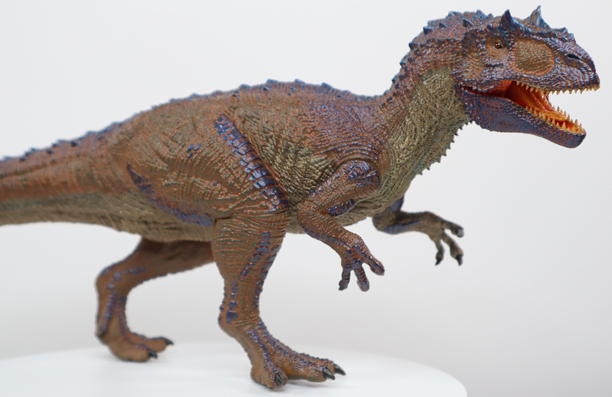New Research Suggests Saurophaganax is Not a Valid Taxon
A recently published scientific paper has challenged the validity of the theropod taxon Saurophaganax maximus. The researchers conclude that S. maximus should be classified as nomen dubium and a new taxon of Allosaurus is proposed – Allosaurus anax. In Latin, nomen dubium translates as “doubtful name”. Essentially, this means that the Saurophaganax genus is not supported anymore.

A scale drawing of the giant allosaurid Saurophaganax maximus. Size estimates vary but fossils of this dinosaur could represent an individual animal between 12 and 14 metres long. The Saurophaganax genus is regarded as nomen dubium. Picture credit: Everything Dinosaur.
Picture credit: Everything Dinosaur
Sorting Saurophaganax maximus
In 1995, palaeontologist Daniel Chure erected the genus Saurophaganax (S. maximus) to describe an extremely large allosaurid dinosaur that had been excavated from the Kenton 1 Quarry in Cimarron County (Oklahoma) back in the 1930s. Unfortunately, the dig site was not that well supervised and mapped when the bones were originally excavated and removed. Several dinosaur taxa were present, and this may have led to confusion between what was defined as theropod and what was thought to be sauropod fossil bone.
In his research, Chure proposed that a dorsal neural arch (OMNH 1123) be declared the holotype specimen for Saurophaganax maximus. This theropod was much larger than Allosaurus fragilis and rivalled the giant megalosauroid Torvosaurus tanneri for the title of the biggest meat-eating dinosaur described to date from the Morrison Formation. Indeed, the Kenton 1 Quarry fossils were thought to represent one of the largest theropods known from the Jurassic of North America. Perhaps these fossils could be from one of the largest, Jurassic carnivorous dinosaurs that ever lived!
This new study proposes that the holotype (OMNH 1123), does not belong to a theropod. The dorsal neural arch is reminiscent of that of a juvenile sauropod. Other referred material such as chevrons and the atlas can’t be assigned to the Theropoda with certainty. Since fossil material cannot be assigned to Saurophaganax, this taxon is considered not valid (nomen dubium).
Saurophaganax has a Chequered History
This dinosaur was named as Saurophagus maximus in 1941. It was later revised to Saurophaganax maximus when it was pointed out that the genus name was already used to describe an extant bird. Numerous unique characteristics were identified in the fossil material which had led to the establishment of a new dinosaur taxon. For example, the postorbital bone in the skull lacking a postorbital boss and the atlas not having any facets for a proatlas. However, the 2024 re-evaluation shows that some of the elements originally used to distinguish Saurophaganax from Allosaurus are more parsimoniously referred to diplodocid sauropods found in the same quarry rather than an allosaurid.
This latest analysis eliminates many of the previously reported traits that distinguished the Kenton 1 Quarry allosaurid from Allosaurus. The research team does not consider a distinct genus is warranted. Despite the similarity of the decisively theropod material to known species of Allosaurus, some elements feature subtle traits and characteristics that suggest they represent a distinct Allosaurus species. Therefore, the researchers conclude that S. maximus be classified as a nomen dubium and a new taxon of Allosaurus is proposed – Allosaurus anax.

The Rebor Saurophaganax maximus model has proved to be popular with collectors. However, a recently published scientific paper questions the validity of this taxon. Picture credit: Everything Dinosaur.
Picture credit: Everything Dinosaur
The picture (above) shows one of the Rebor Saurophaganax replicas that were introduced in 2022.
To view the range of Rebor figures and models in stock: Rebor Figures and Models.
In summary, palaeontologists historically considered this taxon to represent a species of Allosaurus or a very large allosaurid. However, a re-examination of the attributed specimens suggests that it is a chimera of multiple dinosaur genera. Some specimens likely belong to a diplodocid sauropod, while others could be reassigned to a new species of Allosaurus (A. anax).
The scientific paper: “Chimerism of specimens referred to Saurophaganax maximus reveals a new species of Allosaurus (Dinosauria, Theropoda)” by Andy D. Danison, Mathew J. Wedel, Daniel E. Barta, Holly N. Woodward, Holley M. Flora, Andrew H. Lee, and Eric Snively published in Vertebrate Anatomy Morphology and Palaeontology.
The Everything Dinosaur website: Dinosaur Toys and Models.

